Laura Williams led a book club session on the Society of Genes:
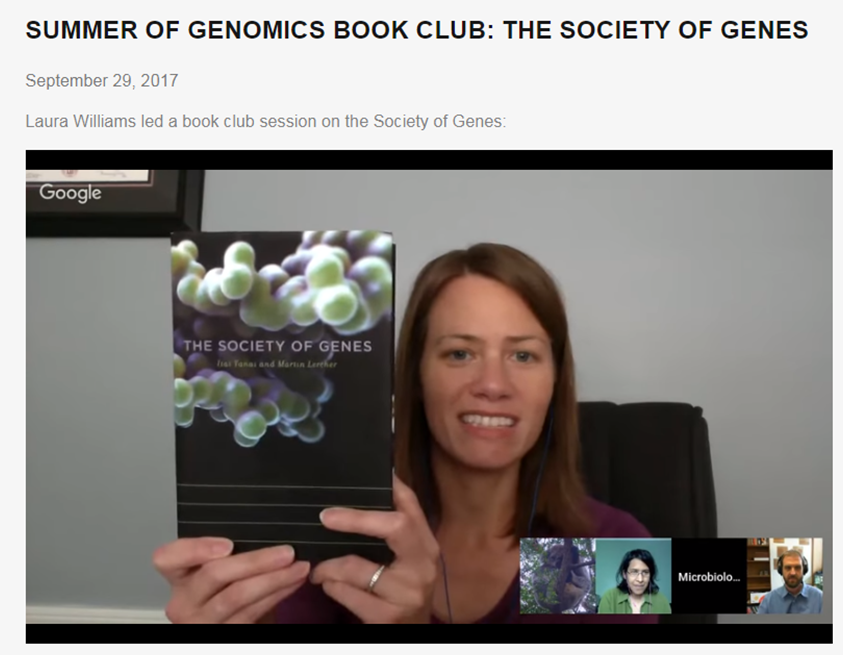
Laura Williams led a book club session on the Society of Genes:
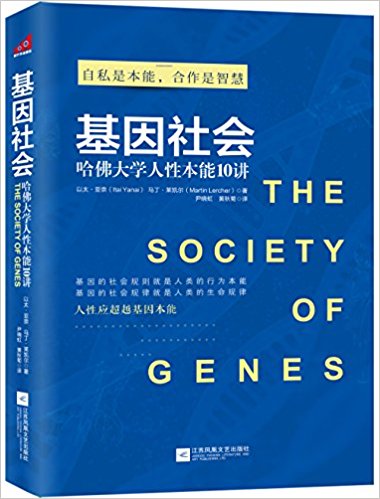
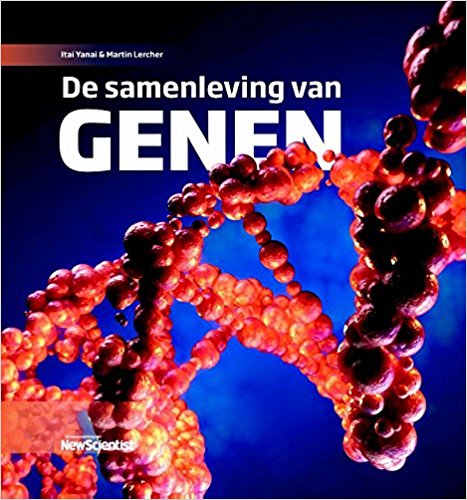
Prof. Elof Axel Carlson reviews the Society of Genes: “It is a book that I hope will find its way into undergraduate courses.”
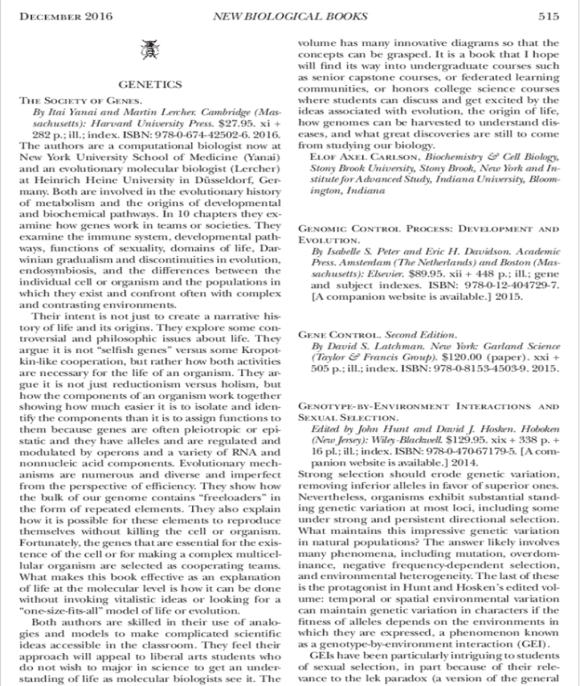
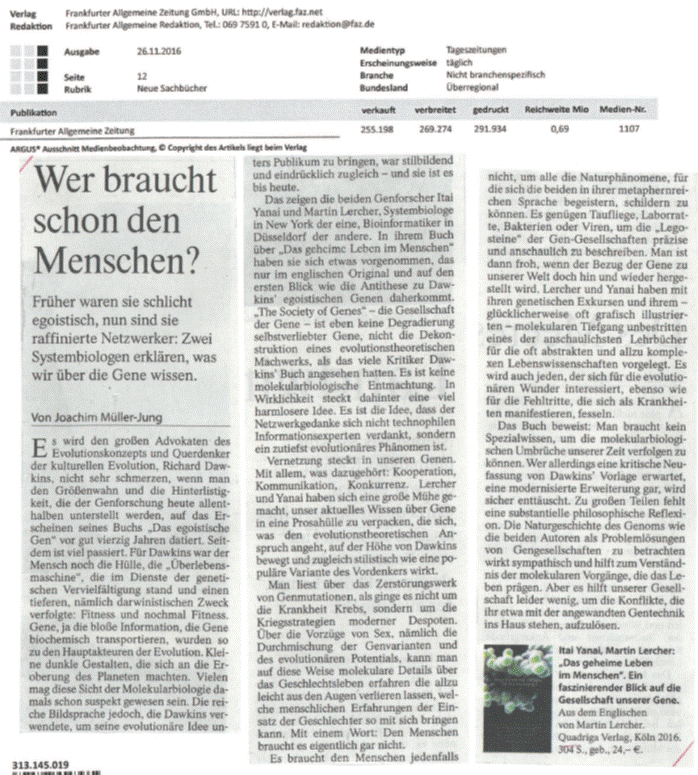
“Lercher and Yanai went to great lengths to pack our current knowledge about genes into a wrapping of prose that is, as far as the aspect of evolutionary theory is concerned, at the level of Dawkins, and the same time comes across stylistically as a popular version of the visionary Dawkins.”
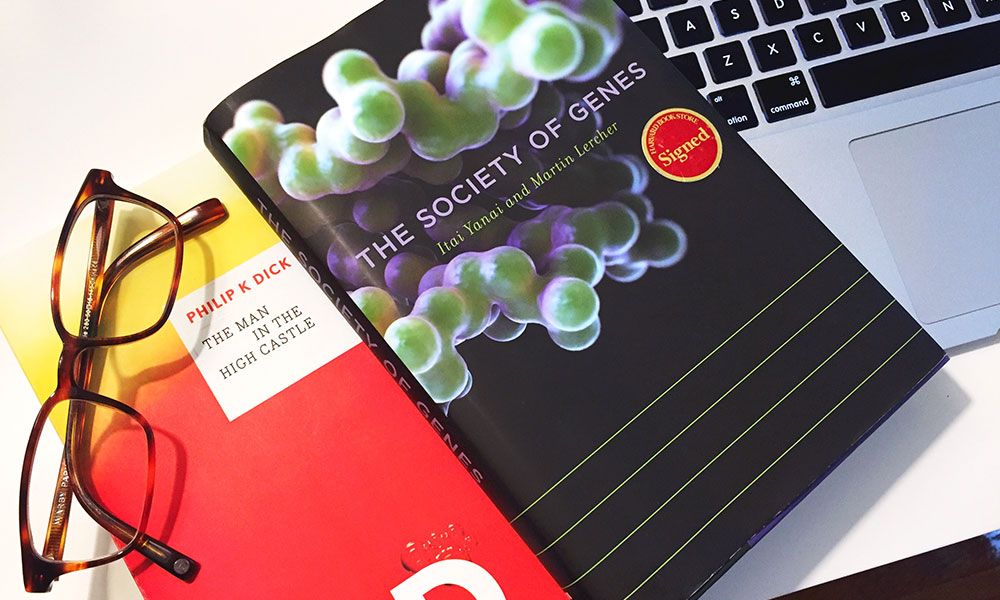
http://crosstalk.cell.com/blog/the-battle-within-our-genome-a-review-of-the-society-of-genes
On a lazy Saturday afternoon, with a latte in hand, I took a walk to my favorite bookstore, thinking that, for a change, I would pick a novel and not a science book. After an hour wandering around the store, I made my choice—The Man in the High Castle by Philip K. Dick. I’d just finished the first season of the TV series, and I was so confused by the show that I figured the book would help me understand what was going on.
I was about to leave, and while I was waiting at the counter, I made the “mistake” of picking up a book that was right in front of me: The Society of Genes. On the back of the book, renowned scientists Michael Levitt and Eric Lander described the book as “punchy” and “thought-provoking.” A “must read.”
How could I resist?
Is The Society of Genes an antithesis, a complement, or an extension to The Selfish Gene, written 40 years ago by Richard Dawkins? Perhaps a little of all three. Dawkins built upon George C. Williams’s theory that our genome is made of genes that solely act for their own survival. Instead, Itai Yanai and Martin Lercher, authors of The Society of Genes and talented system biologists, tell us that our genome is made of a society of genes that, like human societies, is composed of members that form alliances and rivalries. Diving into cancer, immunology, sexual reproduction, and population genetics, Yanai and Lercher tell us how genes interact, collaborate, and battle within our genome.
A first example of genes’ collaboration introduced by Yanai and Lercher is that of cancer-driven mutations. By now, you might have heard about the famous Douglas Hanahan and Robert A. Weinberg review titled “The hallmarks of cancer.” First published in Cell in 2000, the authors revisited their original review 11 years later with “Hallmarks of cancer: the next generation.” Cancer starts when a gene X in our genome acquires a mutation that makes normal cells go crazy—cancer cells divide faster than normal cells and grow even if they’re not supposed to.
Fortunately, our bodies have developed safeguards that protect us from developing cancer after acquiring a single pro-cancerous mutation. While Hanahan and Weinberg described eight ways in which mutations override the body’s safeguards against uncontrolled cell growth, Yanai and Lercher explain to us that genes carrying these mutations “help” each other—cells carrying the first pro-cancerous mutation divide faster, descendants become abundant enough for a new mutation to occur, and so on.
The book is filled with smart and, as Levitt says, “punchy” examples unveiling how genes collaborate or oppose each other. Cancer is by far the easiest one of these to understand, but by opening this book, you’ll also learn about other examples.
One of these is the Clinton Paradox—in 1999, Eric Lander gave a talk at the White House Millennium Lectures in which he explained that the genome of two individuals is 99.9% identical. President Bill Clinton wondered how a 0.1% difference could be responsible for so many wars. But Lander reminds us that 0.1% still represents 6 million letters (our genome being 6 billion letters long). Six million differences is not such a small number and might “justify” some destructive behaviors.
You’ll learn about the “chuman” (half chimpanzee, half human) that people once believed existed. But, as Yanai and Lercher explain, “Genes can mingle between themselves but not with the society of other species.” And you will also learn that, if you’re lactose intolerant, it’s simply because you have an allele that is out of style; indeed, lactose intolerance was considered the natural state of health for thousands of years.
The authors’ comparison between the human brain and the toothbrush company Colgate is very funny. What makes the human brain bigger and smarter than other species’ brains is not that our genome has more genes but simply that some of our genes, found in any other species, are interconnecting with each other in a different way. But what, you might ask, about Colgate? Well, an urban legend says that, years ago, the company was going bankrupt, but that enlarging the hole delivering the toothpaste was enough to save it—the toothpaste didn’t change, but people started using more of it. This is the same idea as in the human brain: the genes are the same, but the way they’re used is different.
And last but not least, let me finish with an example that might amuse feminists: the Y chromosome that distinguishes males from females might soon disappear—yes, the Y chromosome is becoming useless!
Obviously, I don’t do justice to the book with these few examples, and I’ve picked those that I am hoping will push you into opening the book, but believe me, you’ll be surprised by the number of times you’ll stop reading to ask yourself, “Wow, really?” The metaphors used by the authors to depict the society of genes are intelligent, timely, and amusing. This is a book I’m keeping on my coffee table to dig into from time to time, re-read some passages, and look into its humorous illustrations.
The Man in the High Castle was an excellent choice, too, by the way.
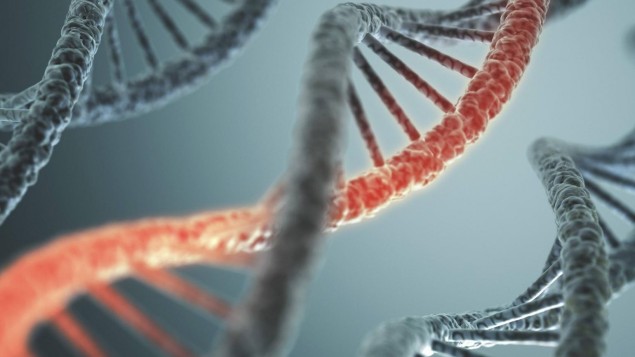
09.09.2016 08:50 Uhr
 Ein Gen ist ein Abschnitt auf einem DNA-Strang. (imago/stock&people/Science Photo Library)
Ein Gen ist ein Abschnitt auf einem DNA-Strang. (imago/stock&people/Science Photo Library)Die Gene konkurrieren miteinander wie Handwerker, schreiben Itai Yanai und Martin Lercher in “Das geheime Leben im Menschen”. Mit ihrem Sachbuch möchten die Wissenschaftler dem Leser das komplexe Thema “Gen-Gesellschaften” näherbringen.
Gene bestimmen unser Leben. Wir erben sie von unseren Eltern und geben sie weiter an unsere Kinder. Sie sind Teil jedes Menschen und gleichzeitig führen sie in uns eine Art Eigenleben. Wer seine Gene verstehen will, sollte sie aber nicht als egoistische Einzelgänger betrachten, sondern als Gen-Gesellschaft. Sie bilden Gemeinschaften, sie arbeiten zusammen, sie wetteifern, und sie können einander austricksen.
Lebendig und detailreich beschreiben zwei führende Wissenschaftler eine abstrakte Welt. Sie erleichtern den Einstieg mit anschaulichen Beispielen und Metaphern, einfachen Grafiken und kleinen Geschichten. Ideal für vorgebildete Leserinnen und Leser, die den aktuellen Forschungsstand der molekularen Biologie aus erster Hand kennen lernen möchten. Aber die beiden Autoren wollen mehr bieten als ein neues Lehrbuch. Sie bringen Evolution und Genforschung zusammen, so wie es bereits vor 40 Jahren der englische Evolutionsbiologe Richard Dawkins vorgemacht hat. Wie ihr Vorbild beschreiben Yanai und Lercher die Gene als kleinste Einheiten der Evolution. Aber sie belassen es nicht dabei, sondern spinnen die Idee weiter. Sie sehen den Wettstreit der Gene eingebettet in einen größeren Zusammenhang. Das Zusammenwirken gibt Regeln vor und verhindert die ungebremste Vermehrung einzelner auf Kosten der Gemeinschaft.
In der Gen-Gesellschaft treffen verschiedene Varianten bestimmter Erbanlagen aufeinander. Sie konkurrieren miteinander, ähnlich wie Handwerker in einer Zunft, wo sich letztlich derjenige sich auf dem Markt durchsetzt, der zu einem akzeptablen Preis die besten Produkte herstellt. Aber auch die Zünfte sind Veränderungen unterworfen. So können Bäcker sich als Brotbäcker spezialisieren oder als Konditoren. Bei der Weiterentwicklung verdrängen die Spezialisten nach und nach die Generalisten. Das führt zu immer komplizierteren Gen-Gesellschaften. Mit diesem Bild können Yanai und Lercher auch erklären, warum Schimpansen und Menschen sich deutlich unterscheiden, obwohl ihre Erbanlagen sehr ähnlich sind. Nicht die Menge oder die Qualität der einzelnen Gene ist verantwortlich, sondern die Wechselwirkungen innerhalb der Gen-Gesellschaften. Erst sie ermöglichte kompliziertere Entwicklungen wie die des menschlichen Gehirns.
Beim Lesen spürt man den hohen Anspruch der beiden Autoren. Sie wollen interessierte Laien in ihr Spezialgebiet einführen. Gleichzeitig präsentieren sie wie einst Richard Dawkins eine neue Sichtweise der Evolution. Das ist an sich ist spannend. Dennoch braucht es trotz aller Hilfestellung ein gerütteltes Maß an Konzentration, um sich in diese fremde, abstrakte Welt zu vertiefen.
Itai Yanai/Martin Lercher: “Das geheime Leben im Menschen – Ein faszinierender Blick auf die Gesellschaft unserer Gene”
Übersetzung: Martin Lercher
Bastei-Lübbe (Quadriga), München 2016
304 Seiten, 24,00 Euro
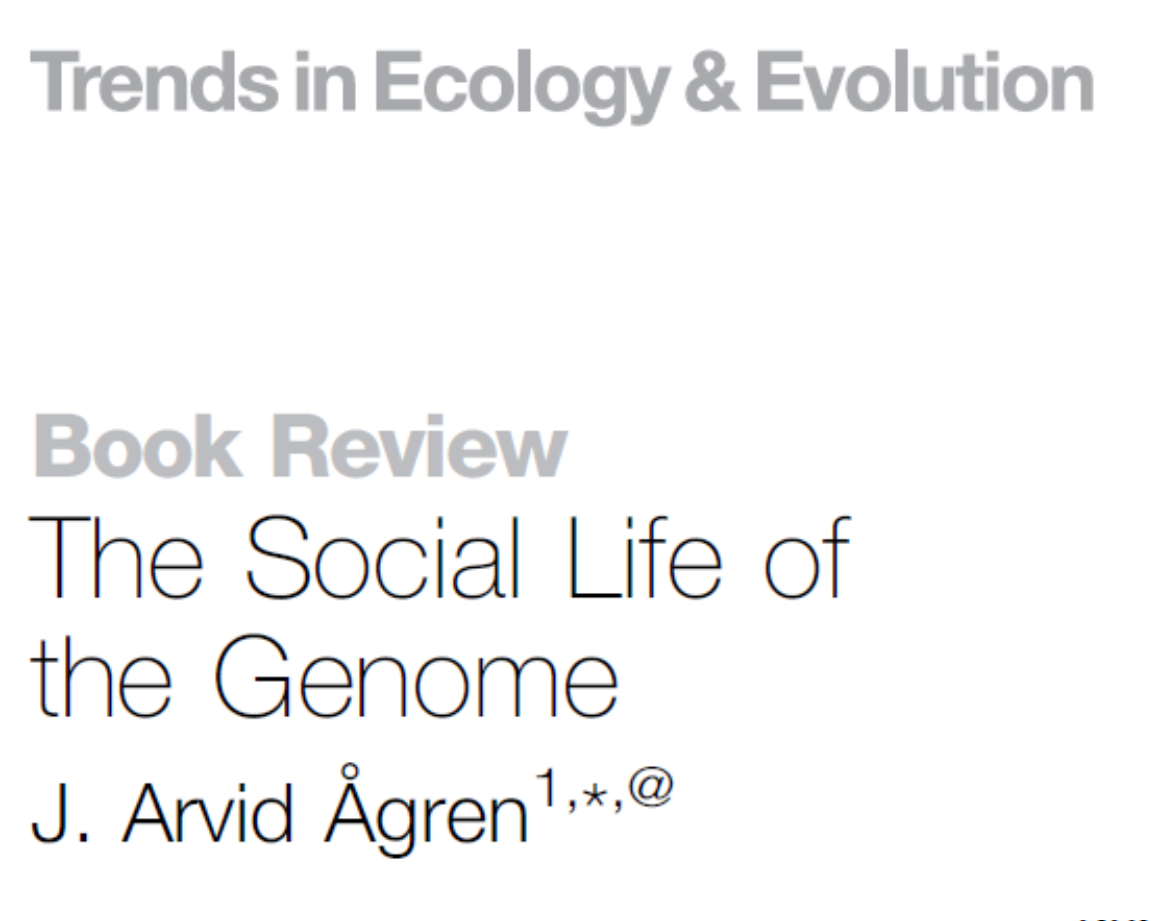
“For many people, professional biologists and laymen alike, The Selfish Gene [1] changed the way they thought about evolution. In the preface of their very lucid book The Society of Genes, authors Itai Yanai and Martin Lercher attribute their career shift to biology, from computer science and physics respectively, to Dawkins’s writing. Forty years on, Yanai and Lercher set out to provide an updated version of the argument that inspired them so much.” J. Arvid Ågren, The Social Life of the Genome
http://www.cell.com/trends/ecology-evolution/abstract/S0169-5347(16)30001-5
https://www.dropbox.com/s/8g920ght77tbhtn/1-s2.0-S0169534716300015-main.pdf?dl=0


“clearly, if not beautifully, written, and remarkably concise… we need books like this.”